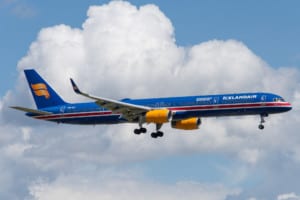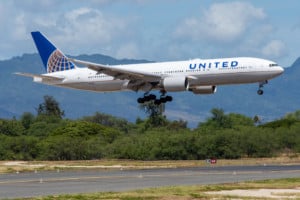In the world of airliners, the Boeing 757 and 777 are two famous jet aircraft. Both models are from the Boeing family and have many similarities, but a few key differences set them apart.
This article will discuss the Boeing 757 and 777’s main differences and how they compare in size, performance, seating capacities, fuel efficiency, range, and cost.
| Aircraft: | Boeing 757-300 | Boeing 777-200ER |
|---|---|---|
| Photo: |
 |
 |
| Country: | United States | United States |
| Manufactured: | from: 1998 to: 2004 | from: 1996 to: Present |
| ICAO: | B753 | B772 |
| Price: | $80 million | $306.6 million |
| Avionics: | Rockwell Collins Avionics | Honeywell Avionics |
| Engine: | 2x Rolls-Royce RB211-535E4/B, Pratt & Whitney PW2000-40/43 | 2x Pratt and Whitney PW 4090 or Rolls-Royce Trent 895 or GE GE90-94B |
| Engine Type: | Turbofan | Turbofan |
| Power: | 43,500 pound-force | 93,700 pound-force |
| Max Cruise Speed: |
496 knots 919 Km/h |
510 knots 945 Km/h |
| Approach Speed (Vref): | 140 knots | 136 knots |
| Travel Range: |
3,467 Nautical Miles
6,421 Kilometers |
7,510 Nautical Miles
13,909 Kilometers |
| Fuel Economy: |
0.3 nautical mile / gallon 0.147 kilometres / litre |
0.17 nautical mile / gallon 0.083 kilometres / litre |
| Service Ceiling: | 42,000 feet | 43,100 feet |
| Rate of Climb: |
3500 feet / minute 17.78metre / second |
3000 feet / minute 15.24metre / second |
| Take Off Distance: |
2600 metre 8,530.08 feet |
2438 metre 7,998.59 feet |
| Landing Distance: |
1550 metre 5,085.24 feet |
1554 metre 5,098.36 feet |
| Max Take Off Weight: |
123,830 Kg 272,996 lbs |
297,550 Kg 655,979 lbs |
| Max Landing Weight: |
101,610 Kg 224,009 lbs |
213,180 Kg 469,977 lbs |
| Max Payload: |
30,940 Kg 68,210 lbs |
59,422 Kg 131,002 lbs |
| Fuel Tank Capacity: |
11,490 gallon 43,494 litre |
45,220 gallon 171,176 litre |
| Baggage Volume: |
67.5 m3 2,384 ft3 |
162 m3 5,721 ft3 |
| Seats - Economy: | 295 seats | 440 seats |
| Seats - Business Class: | 243 seats | 400 seats |
| Seats - First Class: | - | 301 seats |
| Cabin Height: |
2.13 metre 6.99 feet |
2.2 metre 7.22 feet |
| Cabin Width: |
3.54 metre 11.61 feet |
5.86 metre 19.23 feet |
| Cabin Length: |
43.21 metre 141.76 feet |
49.1 metre 161.09 feet |
| Exterior Length: |
54.43 metre 178.57 feet |
63.7 metre 208.99 feet |
| Tail Height: | 13.64 metre - 44.75 feet | 18.5 metre - 60.69 feet |
| Fuselage Diameter: |
3.76 metre 12.34 feet |
6.19 metre 20.31 feet |
| Wing Span / Rotor Diameter: |
38.06 metre 124.87 feet |
60.9 metre 199.80 feet |
| Wing Tips: | Blended Tips | No Winglets |
| More Info: | Boeing 757-300 | Boeing 777-200ER |
|
Data presented is for entertainment purposes and should not be used operationally.
|
Other Boeing 757-300 comparisons:
- Airbus A330-300 vs Boeing 757-300
- Boeing 737-800 vs 757-300
- Boeing 757-300 vs Airbus A321
- Boeing 787-8 vs 757-300
- Boeing 747-300 vs 757-300
Other Boeing 777-200ER comparisons:
About the Boeing 757
The Boeing 757 jetliner has been used by airlines worldwide since its introduction in June 1995. The sleek and powerful bird was first flown on June 12, 1994, and was developed from the Boeing 767, with which many of its characteristics are shared.
Developed to fit between the 737 and 767 for airlines looking for capacity flexibility, the initial debut took place as United Airlines introduced it to modern air travel on June 7, 1995. Manufactured by Boeing Commercial Airplanes, as of October 2022, over 1,696 planes had been delivered worldwide since production began in 1993. With changes being made until this very day in 2021, the original design has proved to be a trusty staple for many carriers despite its advanced age.
Why was it developed and built?
The primary purpose behind the development of the 757 was to offer a smaller, more efficient, and cost-effective aircraft compared to its larger siblings, the 767 and 777. It is a medium- to long-range airliner that can carry 200 to 295 passengers, depending on the configuration. The 757 is much smaller than the 767 and 777, but it can fly farther due to its more efficient engines.
What purpose does it serve?
The 757 is ideal for medium-haul domestic flights within the United States. It also works well on longer transcontinental flights and international routes from North America or Europe to the Caribbean and Central and South America. It is an economical aircraft for carrying medium-sized passenger loads for short or mid-range courses.
About the Boeing 777
The plane has been a reliable staple in commercial aviation since its first flight on June 12, 1994. Developed by Boeing Commercial Airplanes, the 777 introduced itself to the public two weeks later, on June 7, 1995, when United Airlines took to the skies.
Since then, it has been seen as an industry leader as it underwent improvements from generation to generation. Most notable is the recent advances and development of the 777X, which is said to have improved range and fuel efficiency compared to its predecessor model. As of October 2022, Boeing has seen an impressive 1,696 deliveries for their flagship airliner, with more orders in the queue for the next few years.
Why was it developed and built?
This is the largest and most fuel-efficient twin-engine jetliner in the world and was designed to replace Boeing’s 767 and 747. Its wider cabin and larger cargo capacity have allowed it to be used for long-haul flights, such as transcontinental or intercontinental routes.
What purpose does it serve?
It serves as a reliable airliner for long-haul routes. The 777 is capable of flying distances of up to 9,380 nautical miles (17,370 kilometers). It has also proven to be one of the most fuel-efficient aircraft in its class, significantly reducing airline operating costs. Furthermore, the 777’s larger cargo capacity allows airlines to transport more passengers and goods in a single trip.
How are the Boeing 757 and Boeing 777 different?
The Boeing 757 and the Boeing 777 may have similarities, such as being twinjets with ETOPS certification, but when it comes to their differences, they are far more pronounced. The 757 is a narrow-body aircraft, while the 777 is a widebody one, and these two crafts differ significantly in size.
When compared, the 757’s wingspan, length, and height are all considerably less than the 777’s. All variants of the 777 also boast an impressive range potential which is greater than that of all variants of the 757. On top of this, most newer models of the 777 possess superior fuel efficiency, helping airlines keep costs down even on long flight paths.
How are the Boeing 757 and Boeing 777 similar?
There are a few areas in which the Boeing 757 and the Boeing 777 are similar. The two aircraft share a common ETOPS (Extended-range Twin-engine Operational Performance Standards) certification, allowing them to fly longer routes with only two engines.
Both have similar wing structures and boast a wide variety of interior configurations, from economy class to first class.
Finally, both aircraft have an impressive range potential that allows them to reach further distances than most other aircraft.
In summary, the Boeing 757 and the Boeing 777 are both reliable airliners from Boeing that have been used for a variety of purposes.
What’s better about the Boeing 757?
Engine:
The engines of the Boeing 757 are powerful and fuel efficient. The plane is equipped with two high bypass ratio engines, allowing it to fly at higher altitudes while consuming less power. It can fly farther than many other aircraft without sacrificing performance or efficiency.
Development:
The Boeing 757 was designed with an emphasis on passenger comfort and convenience. Its interior is spacious, featuring comfortable seats, ample legroom, and ample overhead storage. It also offers several amenities, such as in-flight entertainment, video monitors, and power outlets to keep passengers entertained during long flights.
Avionics:
The Boeing 757 is equipped with advanced avionics systems, allowing it to efficiently perform sophisticated maneuvers. Its navigational systems are state of the art, utilizing the latest GPS technology to provide the pilot with accurate information and guidance during flight. Additionally, the Boeing 757 has several digital systems that allow it to communicate with other aircraft and control towers more efficiently.
What’s better about the Boeing 777?
Reliability:
The Boeing 777 is known for its reliability and safety, thanks to its sophisticated design and modern engineering. Its airframe is made from solid materials resistant to corrosion, and its engines are designed to be reliable and efficient.
Development:
The Boeing 777 is designed with passenger comfort in mind, featuring a wide interior cabin and more oversized windows to give passengers an enjoyable and spacious flight experience. Additionally, it features more advanced in-flight entertainment systems and modern amenities such as personal video monitors and power outlets.
Speed:
The Boeing 777 is well known for its speed and performance, thanks to its powerful engines and aerodynamic design. It has a top cruise speed of Mach 0.84, meaning it can get from one destination to the next quickly and efficiently. This makes it an ideal choice for busy travelers who must get to their destination on time.
Conclusion
The Boeing 757 and 777 are two of the most popular commercial aircraft in the world, thanks to their reliable performance and comfortable interior cabins. The 757 is an excellent choice for shorter routes requiring efficient fuel consumption, while the 777 is perfect for long-haul flights with its powerful engines and modern amenities. Both aircraft provide a smooth and enjoyable experience for passengers, making them a great choice of travel for all types of travelers.


